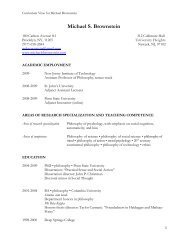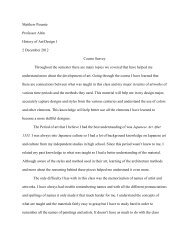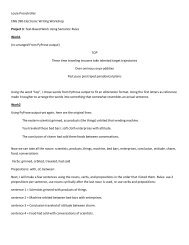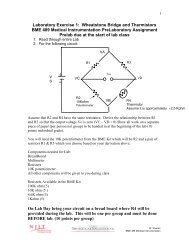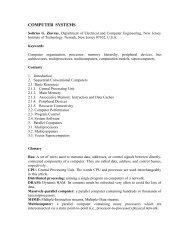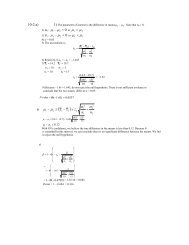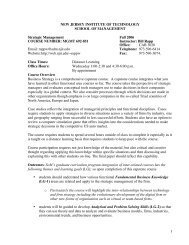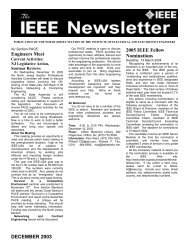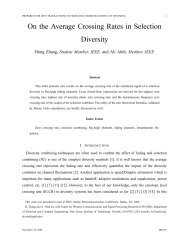Well-conditioned boundary integral formulations for the ... - Njit
Well-conditioned boundary integral formulations for the ... - Njit
Well-conditioned boundary integral formulations for the ... - Njit
You also want an ePaper? Increase the reach of your titles
YUMPU automatically turns print PDFs into web optimized ePapers that Google loves.
Taking into account <strong>the</strong> fact that |ξ · â(ξ)| 2 ≤ |ξ| 2 |â(ξ)| 2 , <strong>the</strong> positivity of <strong>the</strong> expression in <strong>the</strong><br />
left-hand side of equations (38) follows immediately once we establish that<br />
κ 2 R{(|ξ| 2 − (κ 1 + iκ 2 ) 2 ) −1/2 } + κ 1 I{(|ξ| 2 − (κ 1 + iκ 2 ) 2 ) −1/2 }<br />
(<br />
≥ |ξ| 2 κ1<br />
κ 2 1 + I{(|ξ| 2 − (κ 1 + iκ 2 ) 2 ) −1/2 } − κ )<br />
2<br />
κ2 2<br />
κ 2 1 + R{(|ξ| 2 − (κ 1 + iκ 2 ) 2 ) −1/2 } . (39)<br />
κ2 2<br />
The inequality (39) can be seen to be equivalent to <strong>the</strong> inequality<br />
(<br />
I (κ 1 + iκ 2 )[|ξ| 2 − (κ 1 + iκ 2 ) 2 ] −1/2) ( )<br />
|ξ|<br />
2<br />
≥ I [|ξ| 2 − (κ 1 + iκ 2 ) 2 ] −1/2<br />
κ 1 + iκ 2<br />
which in turn is equivalent to <strong>the</strong> inequality<br />
( )<br />
−κ1 + iκ 2<br />
I<br />
κ 2 1 + [|ξ| 2 − (κ 1 + iκ 2 ) 2 ] 1/2 } ≥ 0. (40)<br />
κ2 2<br />
Given that R{[|ξ| 2 − (κ 1 + iκ 2 ) 2 ] 1/2 } > 0 and I{[|ξ| 2 − (κ 1 + iκ 2 ) 2 ] 1/2 } < 0, <strong>the</strong> inequality (40)<br />
follows immediately, and <strong>the</strong> proof is complete. <br />
2.1 Principal symbol regularizing operators<br />
We present in what follows ano<strong>the</strong>r class of regularizing operators that consists of operators that<br />
have <strong>the</strong> same principal symbol in <strong>the</strong> sense of pseudodifferential operators [48, 54] as <strong>the</strong> operators<br />
R defined in equations (11). The calculation of <strong>the</strong> principal symbols of <strong>the</strong> operators R defined<br />
in equations (11) is based on <strong>the</strong> principal symbols of scalar and vector single layer operators S K<br />
and π Γ S K <strong>for</strong> complex wavenumbers K such that IK > 0, where <strong>the</strong> projection operator onto <strong>the</strong><br />
tangent space of Γ is defined by π Γ = (n×·)×n. The principal symbols of <strong>the</strong>se operators are equal<br />
1<br />
to √ and √ 1<br />
I 2 |ξ| 2 −K 2 2 |ξ| 2 −K 2 2 respectively [4, 17, 19, 49], where we view <strong>the</strong> operator π Γ S k in terms<br />
of <strong>the</strong> Helmholtz decomposition and I 2 stands <strong>for</strong> <strong>the</strong> identity 2 × 2 matrix—we assume without<br />
loss of generality that Γ is simply connected. In <strong>the</strong> previous equations <strong>the</strong> variable ξ ∈ T M ∗ (Γ)<br />
represents <strong>the</strong> Fourier symbol of <strong>the</strong> tangential gradient operator ∇ Γ , and T M ∗ (Γ) represents <strong>the</strong><br />
cotangent bundle of Γ [55]. Given that <strong>the</strong> principal symbol of <strong>the</strong> operators 1 2 (−∆ Γ − K 2 ) − 1 2<br />
is equal to<br />
1<br />
2 √ |ξ| 2 −K 2 and <strong>the</strong> principal symbol of <strong>the</strong> operator 1 2 (−∆ Γ − K 2 ) − 1 2 I 2 is equal to<br />
1<br />
2 √ |ξ| 2 −K 2 I 2 [55], <strong>the</strong> previous statement can be expressed more precisely in <strong>the</strong> <strong>for</strong>m [4, 17, 49]<br />
S K = 1 2 (−∆ Γ − K 2 ) − 1 2 mod Ψ −3 (Γ), π Γ S K = 1 2 (−∆ Γ − K 2 ) − 1 2 I2 mod Ψ −3 (TM(Γ)) (41)<br />
where Ψ −3 (Γ) denotes <strong>the</strong> operator algebra of pseudodifferential operators of order −3 on Γ and<br />
Ψ −3 (T M(Γ)) denotes <strong>the</strong> operator algebra of pseudodifferential operators of order −3 on <strong>the</strong> space<br />
of tangential vector fields on T M(Γ). The meaning of <strong>the</strong> notation A = B mod Ψ s (Γ) where<br />
A and B are pseudodifferential operators defined on scalar functions on Γ is that A − B is a<br />
pseudodifferential operator of order s, that is A − B : H p (Γ) → H p+s (Γ); <strong>the</strong> definition is similar<br />
in <strong>the</strong> case when <strong>the</strong> operators A and B are tangential pseudodifferential operators. It follows<br />
immediately <strong>the</strong>n from equations (41) that<br />
( ) T (<br />
) (<br />
n×S K = 1 ∇Γ<br />
0 (−∆<br />
−−→<br />
Γ − K 2 ) − 1 2 ∆<br />
−1<br />
2 curl Γ −(−∆ Γ − K 2 ) − Γ<br />
div )<br />
Γ<br />
1<br />
2 0<br />
−∆ −1<br />
Γ<br />
curl mod Ψ −3 (TM(Γ)).<br />
Γ<br />
(42)<br />
14



